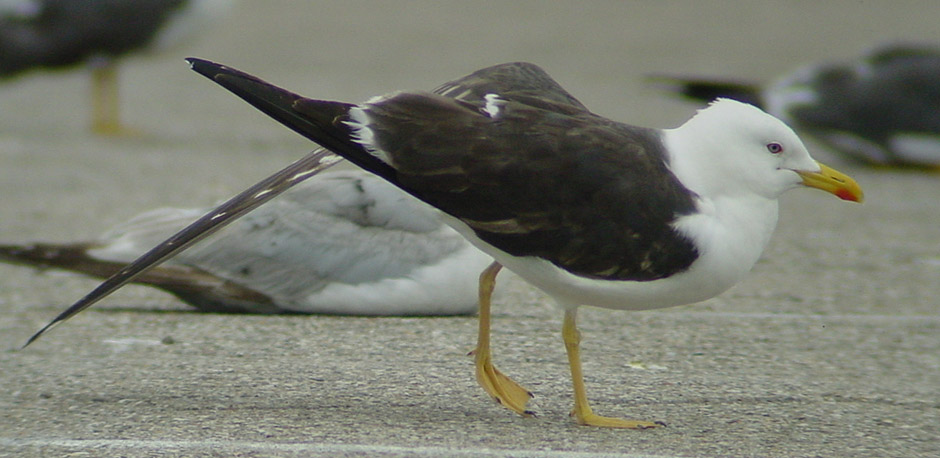 Photo
21: LBBG sub-adult, September 2 2001, ECT parking Maasvlakte, the
Netherlands.
Photo
21: LBBG sub-adult, September 2 2001, ECT parking Maasvlakte, the
Netherlands.  Photo
21: LBBG sub-adult, September 2 2001, ECT parking Maasvlakte, the
Netherlands.
Photo
21: LBBG sub-adult, September 2 2001, ECT parking Maasvlakte, the
Netherlands.
Clearly a sub-adult LBBG (probably from a Scandinavian colony) with some greater coverts still to be moulted. Note the apparently random choice in greater covert moult. Note also the pale tips to the primary coverts, which would be plain grey (with a black centre in some cases) in adults. Primay moult has been arrested at p1. As can be seen in the top picture, p1 has a neat white tip and a grey centre where all other primaries are brownish and the tips from p2 upwards are abraded. P7 is broken at 2/3 of it's length. This is probably a 4cy: p10 has a relatively small white mirror and the bare parts coloration is adult-like. Nevertheless, white mirrors may be present in some (fuscus-like) 2cy LBBGs as well. As the image below shows, p9 and p10 look blackish, darker than the brown bleached p8.
Note that, although the primaries are worn a the tips, the visible secondaries look pretty neat and the tips show no wear, but the brownish centres of the outermost three secondaries are well visible. Were these primaries replaced in spring and now only half a year of age?
Autumn 2001 we tried to get a picture of arrested moult in the innermost primaries in migrating LBBG. It proved to be one of the most difficult features to establish and only few were found with a moult stage less than 10 (at most p2 replaced). On the other hand one may question a wide spread occurrence in the Netherlands of such individuals with arrested or suspended moult. It is reasonable to presume these are not the birds taking long rests in the Netherlands, spending time in or near the colony. LBBG arresting or suspending the primary moult are probably keen to get to southern latitudes as quick as possible, therefore it may be questionable to find such birds in large numbers in resting groups. Maybe research of newly arriving LBBG from the north at location along the southern France coast or in Portugal will give answers to the occurrence of these birds.
